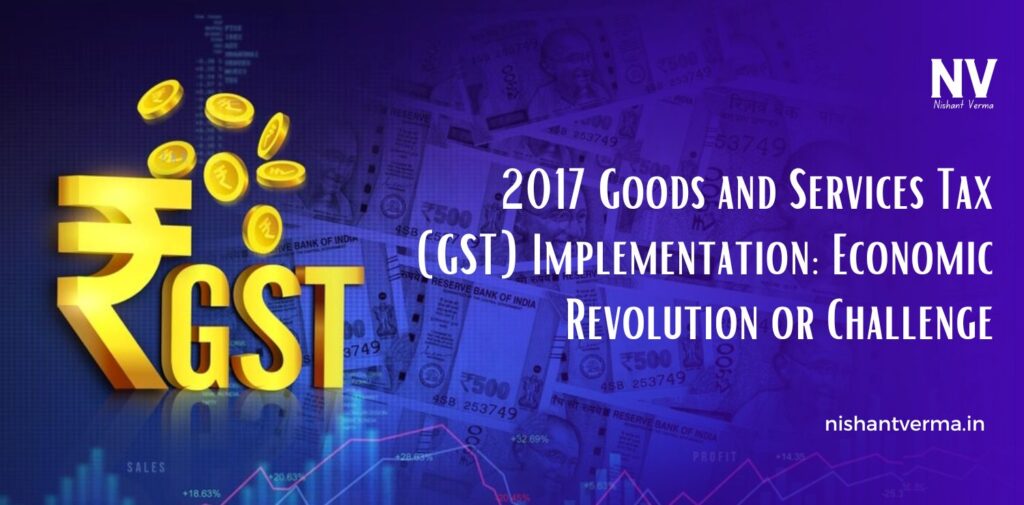The Goods and Services Tax (GST) is considered one of the most significant economic reforms in India’s history. Introduced in 2017, GST aimed to simplify the complex tax structure that had been in place for decades. Prior to its introduction, India had a multi-layered tax system, which included central and state taxes, excise duties, sales tax, and other levies.
The introduction of GST sought to unify this system into a single tax, making it easier for businesses to comply and for the government to collect taxes. However, while GST has undoubtedly brought numerous benefits, it has also faced its fair share of challenges. In this article, we will explore whether GST has been an economic revolution for India or whether it has posed more challenges than expected.
What is GST and How Does It Work?
GST is a single tax levied on the supply of goods and services, which means that it replaces multiple indirect taxes, including excise duty, sales tax, service tax, and VAT. It is a destination-based tax, which means that the tax is collected at the point of consumption rather than the point of production. GST aims to eliminate the cascading effect of taxes, which occurs when a tax is levied on another tax.
Under the new system, goods and services are taxed at various rates, including 0%, 5%, 12%, 18%, and 28%, depending on the nature of the product or service. The tax is collected in stages, with businesses allowed to claim input tax credits on taxes paid on raw materials and services, making the final tax burden much lighter than the previous system. GST was implemented in India on July 1, 2017, and since then, it has affected various sectors of the economy.

Economic Revolution: Benefits of GST
GST has certainly made a significant impact on India’s economy, and there are many reasons why it can be considered an economic revolution. One of the most important benefits of GST is the simplification of the tax structure. Before GST, businesses had to navigate a maze of different taxes at both the state and central levels. This was a time-consuming and expensive process. The introduction of GST eliminated the need for businesses to comply with multiple tax laws and instead provided a single tax structure that applies across the country.
Another major advantage of GST is the reduction in the cascading effect of taxes. Under the previous system, goods and services were taxed at each stage of production and distribution, leading to a higher final price for consumers. GST ensures that tax is only levied on the value added at each stage of production, allowing businesses to claim credits on taxes paid on inputs. This reduces the overall tax burden on businesses and helps lower the final price of goods and services for consumers.
GST has also promoted a more transparent and organized business environment. Since businesses are required to file GST returns online, it has increased the level of compliance and reduced the scope for tax evasion. The digital nature of the GST system has brought greater accountability to the taxation process, making it easier for the government to track transactions and ensure that taxes are paid correctly.
Additionally, GST has played a significant role in reducing the complexity of doing business across state borders. Under the old tax system, businesses had to deal with different tax structures and rates in each state, which made interstate trade cumbersome. GST has replaced state-level taxes with a unified system, making it easier for businesses to transport goods across state lines and expanding the scope for trade. This has helped promote the “One Nation, One Tax” concept, where goods and services are taxed uniformly throughout the country, fostering economic integration.
Challenges and Struggles Post-GST Implementation
While the benefits of GST are clear, the implementation of the new system has not been without its challenges. The most immediate impact of GST was the initial confusion and adjustment required by businesses, especially small and medium-sized enterprises (SMEs). Many businesses were unprepared for the sudden shift to a new tax system, and the complex registration process and compliance requirements proved overwhelming for some.
One of the most significant challenges faced by businesses was the increased administrative burden. GST requires businesses to file multiple returns every month, including a sales return, purchase return, and summary return. This has placed a significant burden on businesses, particularly smaller ones, who may not have the resources to manage these requirements effectively. Additionally, the digital nature of the system means that businesses need to have a certain level of technological infrastructure and expertise, which has posed a challenge for some.
Another challenge faced by businesses was the introduction of multiple tax slabs. While the intention behind this was to ensure that different products and services are taxed appropriately, it has created confusion for businesses trying to determine the correct tax rate for their products. For example, some products may be taxed at 12%, while others are taxed at 18%, leading to uncertainty and mistakes in tax calculations. This has also led to complaints from businesses that the number of tax slabs should be simplified further to make the system easier to understand.
The initial glitches in the GST network (GSTN) also contributed to the confusion. The GSTN, the online portal where businesses file their returns and manage tax-related transactions, faced technical issues during the early months of implementation. These problems made it difficult for businesses to file returns on time and claim input tax credits. While the situation has improved over time, the initial technical difficulties highlighted the challenges of implementing such a large-scale reform.

Impact on the Common Man and Small Businesses
The implementation of GST has had mixed effects on the common man. On one hand, the reduction in cascading taxes has resulted in lower prices for many goods and services, benefiting consumers. For example, goods like refrigerators, air conditioners, and mobile phones saw a reduction in taxes, leading to price cuts. Similarly, services like hotel accommodations and restaurant bills were brought under the purview of GST, leading to lower prices in some cases.
However, there were also instances where the prices of goods and services increased due to the new tax system. Many essential goods, including some food items, saw higher tax rates, which led to price hikes. Small businesses, in particular, were hit hard by the compliance requirements of GST. With limited access to resources and technology, many small businesses found it difficult to navigate the complex filing process. This led to a slowdown in business activity in some sectors, especially for the informal economy, which is a significant part of India’s economy.
Another area of concern was the impact on the agricultural sector. Although many agricultural products were exempt from GST, the increased cost of logistics and transportation, which were subject to tax, led to higher costs for farmers. Many farmers also struggled with the paperwork and registration process required for GST compliance, which posed additional challenges for them.

GST and Its Long-Term Economic Impact
Despite the initial struggles, experts believe that the long-term economic impact of GST will be positive for India. In the long run, the simplification of the tax system and the reduction of tax evasion will lead to higher tax revenue for the government, which can be used to fund infrastructure development, social welfare programs, and other public services. The formalization of businesses, especially in the informal sector, will also lead to more organized industries and a more structured economy.
Moreover, as businesses and consumers become more accustomed to the GST system, the administrative burden is expected to decrease, and compliance will improve. The development of the GST network will likely continue to enhance its efficiency and ease of use, making it more accessible for businesses of all sizes.
India’s move to a unified tax system has also set an example for other countries, especially in the developing world, where complex tax systems often hinder economic growth. The success of GST in India, despite the challenges, can serve as a model for other countries looking to modernize their tax structures.
Conclusion: 2017 Goods and Services Tax
The Goods and Services Tax (GST) implemented in 2017 was undoubtedly a bold and transformative reform that aimed to simplify India’s tax system and improve the ease of doing business. While it has faced challenges, especially during its initial phase, the long-term benefits are clear. By reducing tax complexity, promoting economic integration, and ensuring greater tax compliance, GST is expected to boost India’s economic growth and bring about a more organized business environment.
For GST to be fully successful, ongoing support from the government, continuous improvements in the system, and greater awareness among businesses and consumers will be necessary. Although the journey has been difficult, the ultimate goal of creating a simpler and more efficient tax structure for India remains within reach. Ultimately, GST represents not just an economic reform but also a step toward modernization and growth in India’s economic landscape.




